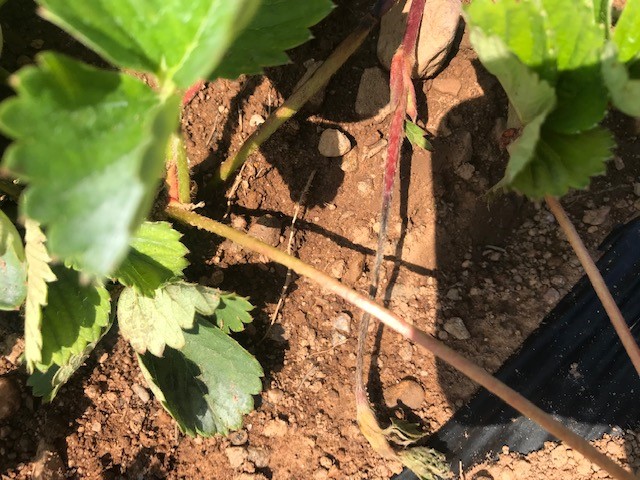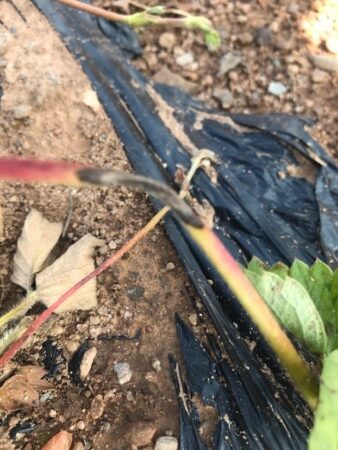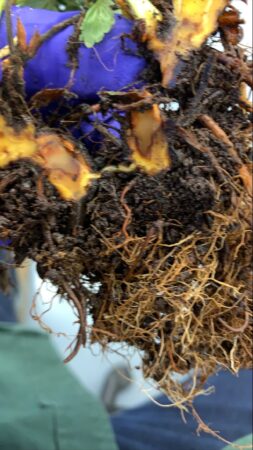
Features
Diseases
Be on the lookout for diseases this fall
October 18, 2023 By Sonny Murray, berry specialist, Perennia Fruit and Agriculture
 Figure 1: Anthracnose infections on runners and petioles begin as a small red streak and develop into dark, sunken, elongated lesions. Lesions will eventually encircle and cause girdling. Daughter plants or leaves above the infection will eventually die. Photos courtesy of Perennia.
Figure 1: Anthracnose infections on runners and petioles begin as a small red streak and develop into dark, sunken, elongated lesions. Lesions will eventually encircle and cause girdling. Daughter plants or leaves above the infection will eventually die. Photos courtesy of Perennia. Much of Eastern Canada is experiencing a very wet season. Although the June-bearing crop is behind us, we need to be thinking of the impact this weather is already having on next spring’s crop. With the possibility of a further wet fall, two major problems quickly jump to mind: Anthracnose and Phytophthora crown rot.
Anthracnose incidence has been a huge issue for everbearing producers this year due to frequent and heavy rainfall. Many of the June-bearing growers avoided heavy fruit infection, but the everbearing fruit producers were dealing with devastating yield loss. Anthracnose spores are largely transferred by water droplet splashing. Weather conditions of high temperatures and high humidity favour Anthracnose’s spread and development. Anthracnose can develop on any part of the plant, including leaves, petioles, runners as well as fruit.

Dark, sunken, elongated lesion denoting Anthracnose infection.
Market garden growers should be aware that Anthracnose on peppers, tomatoes and highbush blueberries is all caused by the same species. So, tight rotations with these crops, or workers and equipment moving between crops, can rapidly spread the disease. Much effort has been put into the control of this disease due to the spread of group 11 resistance, so we won’t go into a lot of depth here. It’s important for June-bearing growers to get into their strawberry fields to assess the amount of disease in their field, as this will be an indication of the amount of inoculum that will be carried over and dealt with in the spring crop. In the future, some growers are considering adding a group M4 to their summer powdery mildew sprays on establishment plantings to broaden their leaf disease protection and also help reduce some of the vegetative anthracnose infections, thereby reducing the amount of overwintering inoculum.
Phytophthora crown rot can be a devastating disease. This disease can persist in a field as a spore for a long period of time or can be introduced on plant stock. During ideal conditions, mobile zoospores are formed, which then spread the disease from plant to plant, travelling in the free water within the soil. Under warm, wet conditions, this disease can spread very quickly up and down the row.

Figure 3: Phytophthora crown rot creates a pronounced, reddish-brown, corky rotten area. This area cuts off the flow of water and nutrients to the top of the plant, creating wilting and eventual death.
It is important to keep an eye out for this disease, concentrating initially in the low spots of the field. Growers will first notice plants wilting as if they were drought-stressed and then recovering at night. Eventually, the plant will collapse entirely. These plants will fall behind in development compared to their healthy neighbours. When the crown is cut open at length, a reddish-brown, corky, rotten area will be pronounced. This area is cutting off the flow of water and nutrients to the top of the plant, creating wilting and eventual death. Neighbouring plants may already be infected and showing earlier symptoms, including a blueish tinge to the leaves, necrotic leaf margins, necrosis developing into the leaf between the veins and some old leaves dying off.
In the past, it was common for many growers to treat newly planted strawberries soon after planting and again in 30 days. While the industry in the Maritimes may have gotten away from this practice, after experiencing two wet falls in a row, many growers are now considering returning to this method.
The old standby treatment for Phytophthora was a drench of Ridomil Gold at the timing for Red Steele, as per the label. The more recent registration of Orondis Gold has made treatment much easier, having Phytophthora on the label, treatment options for both spring and fall, and a 30-day pre-harvest interval. Orondis Gold contains metalaxyl-M (group 4), the same active in Ridomil Gold, as well as Oxathiapiprolin. Oxathiapiprolin (group 49) can disrupt Phytophthora at multiple stages in its life cycle, so it is very effective at controlling the disease. Growers should use alternative modes of action to maximize disease control and rotate to alternative modes of action throughout the season. Growers can also expect activity on Phytophthora by using Aliette (group P07) when controlling Red Steele, and Phostrol (group P07) when controlling Leather Rot. Keep in mind the pre-harvest interval of 30 days and three days, respectively.
Growers should be out in the fields now, assessing levels of anthracnose and phytophthora infections so they know what to expect next spring and work with their crop advisors to be better prepared for what lies down the road.
Print this page